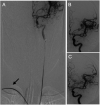Transradial access for pediatric teenage neurointervention: A single-center case series
- PMID: 34515565
- PMCID: PMC9326862
- DOI: 10.1177/15910199211041868
Transradial access for pediatric teenage neurointervention: A single-center case series
Abstract
Transradial access is widely used in cardiological adult interventions and less in pediatrics. In recent years, this access has become more popular in the neuroradiological community in adult patients since it has fewer complications and is more comfortable for the patient after the procedure. We present a single-center case series of 52 transradial access neurointerventions (43 angiographies and 9 therapeutic procedures) in pediatric patients, with a failure of 4 cases (7.7%) in which we could not puncture the artery, crossing over to transfemoral access. Since in five cases we did angiography followed by therapeutic intervention, thus doing only one puncture access for both procedures, then our access failure rate was 10.6%. The 34 successful transradial access solely angiographies had a median radiation exposure of 887 mGy (interquartile range 628-1352), median fluoroscopy time of 9.5 min (interquartile range 7.5-15.3), and median procedure time of 28 min (interquartile range 24-33 min) Therapeutic procedure diagnosis were: one ruptured saccular aneurysm, two juvenile nasopharyngeal angiofibromas, and five arteriovenous malformations. The transradial access neurointerventions for pediatric population older than 11 years is safe and feasible, having previous experience in adults. Younger population should be considered on a case-to-case basis, depending on ultrasound measurement of the arterial diameter and the materials available.
Keywords: Intervention; aneurysm; angiography; arteriovenous malformation; pediatrics.
Conflict of interest statement
Figures


References
-
- Matsumoto Y, Hokama M, Nagashima H, et al. Transradial approach for selective cerebral angiography: technical note. Neurol Res 2000; 22: 605–608. - PubMed
-
- Iwasaki S, Yokoyama K, Takayama K, et al. The transradial approach for selective carotid and vertebral angiography. Acta Radiol 2002; 43: 549–555. - PubMed
-
- Campeau L. Percutaneous radial artery approach for coronary angiography. Cathet Cardiovasc Diagn 1989; 16: –7. - PubMed
MeSH terms
LinkOut - more resources
Full Text Sources

